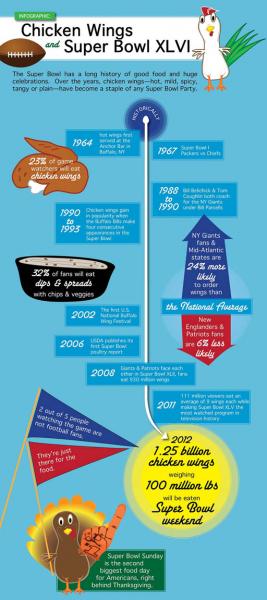
The National Chicken Council estimates that Americans will consume nearly 1.25 billion wings during this year’s Super Bowl.In 1964, Teressa Bellisimo, co-owner of Buffalo, New York’s Anchor Bar, decided to deep-fry chicken wings and toss them with a buttered cayenne pepper sauce. The buffalo wing was born, and since then Americans have made this food a staple.
February 1, 2012

Whether you are an avid football fan who can’t wait until kickoff or you’re part of the 40 percent going to a Super Bowl party just for the food, there’s a good chance you will be as close to chicken wings as the television on Sunday. In fact, the National Chicken Council estimates that Americans will consume nearly 1.25 billion wings during this year’s Super Bowl.
Until 1964, wings were mostly viewed as the less desirable part of the chicken and were mostly cooked in soups. That all changed when Teressa Bellisimo, co-owner of Buffalo, New York’s Anchor Bar, decided to deep-fry chicken wings and toss them with a buttered cayenne pepper sauce. The buffalo wing was born, and since then Americans have made this food a staple—especially during sporting events.
If you’re not part of the 90 percent who will order your wings from a restaurant or market, USDA’s Agricultural Marketing Service (AMS) has some helpful chicken buying tips for homemade wings. While all chicken is inspected to make sure it is safe to consume, understanding grading and classes of chicken will help you choose the right type of chicken.
Grade A chicken wings are plump and known to have a moderate amount of meat. They’re typically a chef’s preferred choice for making Buffalo wings. AMS employees grade wings and other poultry products to make sure customers are receiving high quality chicken.
AMS also gathers market data, including pricing trends, and has been producing a retail price report specifically for chicken and Super Bowl weekend. The report includes the average retail price of chicken wings and other game time favorites like chicken tenders.
Back in 2008, the last time the Giants and the Patriots met in the Super Bowl, AMS market news specialists estimated that the average football fan consumed nearly 86 pounds of chicken throughout the year—a huge increase from the 32.5 pounds per year average from 1967, the year of the first Super Bowl.

The infographic highlights some interesting chicken facts from a variety of sources like the National Chicken Council. You can also take a look at our non-graphic fact list.
Enjoy the Super Bowl!
You May Also Like



